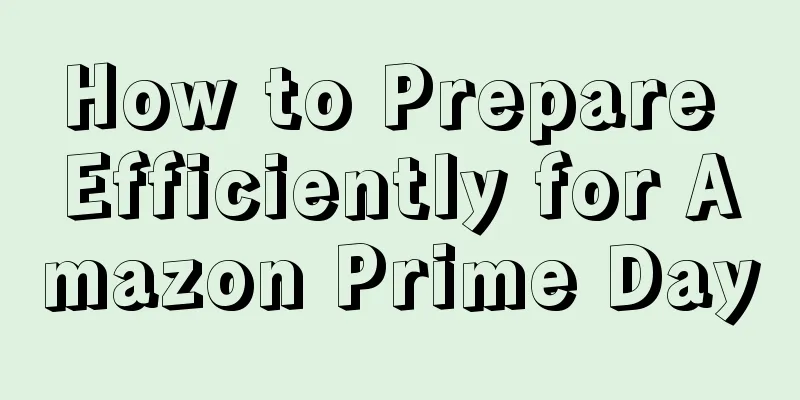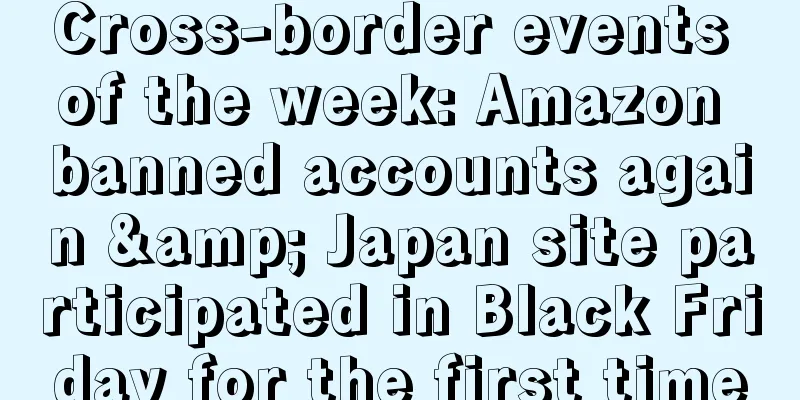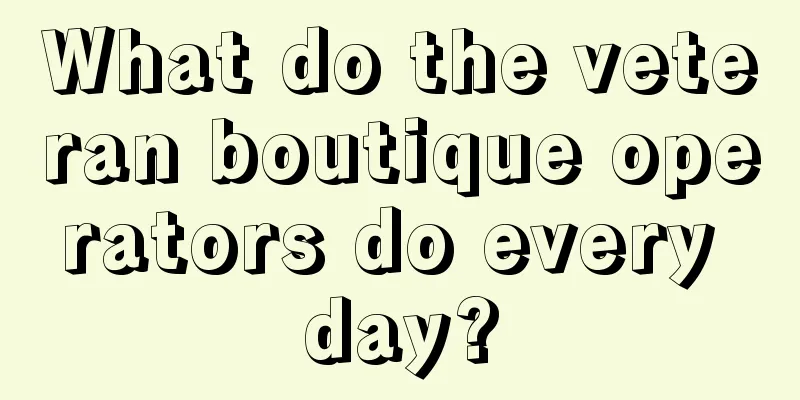Big seller shares: Dear experts, what is your company’s product selection philosophy?

|
Author: Weibo @_大桃纸阿 Original title: The evolution of product development ideas. The following is reproduced with the author's permission. If you need to reprint, please contact the original author I happen to be rethinking and planning the company's product line recently. A great person actually paid me to ask me questions about product selection, so I put all the energy I put into writing the college entrance examination essay into writing this article. . .
Stage 1: Experience-based product selection "The method of selecting products through experience is that when you have enough knowledge about a small category market , you will naturally know which attributes are easy to sell, and then add appearance and quality, and that's it."
This is what I said when the questioner asked me the same question last time. In fact, this was my product selection idea when I first quit my job and started working on my own.
A sufficient but not necessary condition here is that before this I had two or three years of experience in a fine-grained company, and had a certain practical understanding of the market size and competitive situation of almost all secondary categories under a certain major category in the Amazon European market.
Why is it a non-essential condition? Because in my opinion now, this stage can be completely replaced by the so-called data-based product selection tools and certain methodologies.
It’s just that practical experience can more effectively avoid many data blind spots and traps.
In practice, I used my experience to quickly and clearly define the product selection range (6-8 blue ocean secondary category markets with insufficient competition under the same category), and then look for corresponding supply chain resources, discovering products with higher appearance, higher quality and better performance than the existing Top 30 products in the AM market from the supply chain end as entry points.
(ps: You may not always find such products, so in the end only three secondary category products were left. The specific screening criteria and principles are long, so I won’t go into detail here.)
Why appearance? Because pictures can easily and intuitively show the differences and advantages of your products. Why quality? Because it is related to the later operation of the product, the focus of customer reviews and the life cycle of the product. Why three? Because if one or two products fail, there is still one to fall back on.
Fortunately, the sales of the last three products all delivered satisfactory results. Phase 2: Vertically develop blue ocean market Since the product sales have been confirmed, these three are indeed blue ocean markets, the market capacity is OK, the competition level is OK, and the competitive background is also OK. At this time, my product selection idea evolved into: I want to vertically explore the blue ocean market in these three markets and expand the three products into three product lines.
When it comes to vertical digging, many people may immediately think of crowd segmentation and scene segmentation. But I'm sorry, we haven't reached this level yet. At this time, we are still in the stage of finding products, not making products.
Well, it’s just that LOW.
However, at this time I have narrowed the scope to the secondary category. In fact, what I need to develop are similar and homogeneous products to enrich my three product lines and ultimately form a serialized product development and operation strategy.
In practice, this means looking for more niche blue oceans that can be entered from both the market demand side and the supply chain side.
Of course, all of this is still based on the prerequisite that people [certain market experience/market research basis], goods [existing products of manufacturers], and the market [imperfectly competitive market].
Market & demand side: 1. The next level category node; 2. A series of products with the same main keyword; 3. Products with the same function but different themes; 4. Products with different functions in the same scenario. Supply chain: 1. Different manufacturers of homogeneous products; 2. The entire product line of the same manufacturer.
Phase 3: Vertically explore market segments After a period of development, operation and elimination of the refined product strategy, three relatively complete product lines have basically taken shape. At this time, whether it is the development of the competition level of the market itself or the development of our own business (it was around this time that we began to shift from working alone to corporate operations), we have reached the stage where we need to make more refined operations.
The existing products we can find on the supply side can no longer meet the market demand we understand, nor can they meet our needs for breakthroughs at the operational level. Therefore, the focus of product selection at this time falls on [differentiation and micro-innovation].
A great man once said: "The essence of differentiated inspiration is customer demand." So starting from the demand side, the most basic approach is to review, research and analyze - discover pain points - solutions. Reviews include reviews on Amazon, as well as reviews on external social platforms and related forums (Youtube, Quora, Reddit, etc.)
Another great person once said: “Keywords are the most direct expression of customer needs.” Then starting from the demand side, another way is to explore long-tail demand from keywords. Sources of long-tail keywords include Amazon’s ABA, as well as other on-site and off-site keyword tools (JS, SellerSprite, Googletrends, etc.)
And another... Oh no, this is what I said (nonsense): "The ultimate goal of differentiation is to cater to customer needs and gain greater profits." This means that the direction of differentiation is a certain traffic base + better conversion + higher cost-effectiveness. Starting from traffic (operational side): combining popular elements, increasing functional selling points, etc. Starting from conversion and cost-effectiveness (product side): precise segmentation of population, precise segmentation of scenarios, increase/reorganization of accessories, improvement of appearance, improvement of process/quality, optimization of packaging/size, multi-PCS packaging, etc.
Phase 4: Vertically dig deeper into the original category + horizontally expand new categories Vertically dig deep into the original category (discover customer needs and customize products) + horizontally expand new categories (Niche, Trending Product). Regarding the issue of digging deep into the market segments, if I was still at the simple micro-innovation level before, now it can be regarded as a bold move with a lot of money.
Yes, we knew that the education market was difficult and costly, but we couldn't help but take this step. Although the current situation of the product does not look optimistic, we will put it aside for a while, hoping that one day it will be successful.
The idea of expanding into new product categories originates from personal anxiety about the limitations and risks of a single category.
Therefore, the company’s current product selection focus is actually to vertically explore the original categories and horizontally develop new categories in parallel. Vertically, we focus on micro-innovation and iterative products, supplemented by attempts to customize and develop new products.
Horizontally, we develop new product categories with a focus on discovering trends and exploring new blue oceans.
Let me share some practical experience with the two new categories I entered this year: Practical experience 1. Identify the long-term trend. 2. Directly enter the blue ocean, and enter the blue ocean of segmented demand from the red ocean. 3. The general direction of product selection principles is to return to the original product selection ideas of the original category. In detail, the limitations and risks of the original category are analyzed, and emphasis is placed on complementary product attributes. Before I end, let me share a few small insights. After discussing so many product selection ideas, there is actually no distinction between high-level and low-level ones. It does not mean that you can select a hit product by following these ideas. After all, they are basically metaphysical generalities.
Personally, I think product selection is a non-independent and gradual process. No matter what the idea or strategy is, the key is to achieve the best match with your own/company resources (including supply chain, operational capabilities, funds, etc.).
Finally, I’m not a product developer. I’m just a plain and boring Amazon operator. The above is actually a homework I submitted after following the product development master HK, who has been in the product circle for more than half a year. Over.
Finally, a small interaction, as the title May I ask the master, what is your company's product selection strategy? |
<<: How do private label sellers find reliable suppliers?
Recommend
What is Seller Fulfilled Prime? Seller Fulfilled Prime Review
Seller Fulfilled Prime is a program launched by Am...
Shein encounters another turmoil before IPO, and 16 US states ask it to review its supply chain
It is learned that on August 29, Reuters reported ...
What are Social Sharing Buttons? Social Sharing Buttons Review
Social Sharing Buttons is a social network sharing...
US beauty consumption in 2023: Amazon falls out of favor, young people are planting seeds on TikTok
It is learned that in May this year, PoweReviews s...
What is iSpionage? iSpionage Review
iSpionage is a competitive intelligence tool that ...
What is Craigslist? Craigslist Review
Craigslist is a large-scale free classified advert...
Catch store opening process
Catch Store Opening Guide Entry conditions Profess...
Changes in order volume of US e-commerce platforms in Q4, Amazon and Shopify both grew
It is learned that on January 18, warehousing and ...
What is SCITOO? SCITOO Review
Scitoo (Shenzhen Scitoo Industrial Co., Ltd.) is h...
Amazon changed its face overnight! There are major changes in its brand review policy!
Since the beginning of this year, brands have been...
Some of the cool things about Amazon's flash sales
Today I will mainly take you to understand the fac...
What is TradeMore? TradeMore Review
TradeMore is an emerging payment collection platfo...
A bug was discovered in Amazon's backend! Will there be another change in the shipping policy?
This morning, many sellers discovered that there ...
A new way to request reviews! Just now, Amazon fully opened up...
It is said that there is no Amazon seller who does...
What is Shenzhen Blue Whale Cross-border Logistics Co., Ltd.? Shenzhen Blue Whale Cross-border Logistics Co., Ltd. Review
Shenzhen Blue Whale Cross-border Logistics Co., Lt...







![[Recommended Collection] Amazon Super Full Case Path (29 types in total)](/upload/images/67e775b2a191a.webp)

